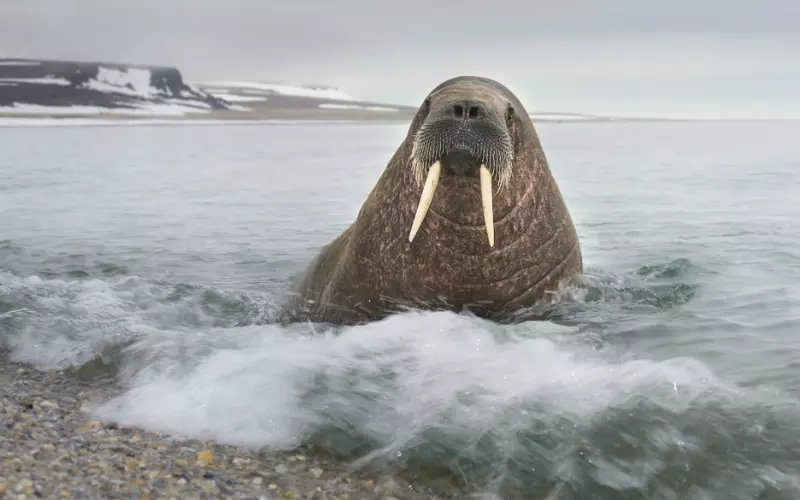Welcome to our blog, where we will explore the fascinating world of animals! In this blog post, we will delve into the intriguing world of walruses. Walruses, also known as Odobenus rosmarus, are one of the most impressive marine mammals found in the Arctic region. These amazing creatures have a long history, unique characteristics, and intriguing behaviours to discover.
Walruses have a rich history that dates back millions of years. Fossils reveal that their ancestors lived during the Miocene period, making them one of the oldest species on Earth. Since then, they have adapted to the harsh Arctic environment, developing remarkable features such as their iconic long tusks, flippers, and blubber layer. These characteristics play a crucial role in their survival and everyday life.
When it comes to size, walruses are truly remarkable. Males can weigh up to a whopping 1.5 tons, making them one of the largest pinnipeds, a group of animals that includes seals, sea lions, and walruses. Their size doesn’t end there! Adult males also possess impressive tusks that can grow up to 3 feet in length. These tusks are not just for show but serve various purposes, such as helping them haul themselves onto ice floes or establishing dominance within their social hierarchy.
Walruses live in the cold Arctic waters and prefer to haul out on ice, where they rest, take care of their young, and socialize with other walruses. Their habitat provides them with ample opportunities to find food, as they primarily feed on bottom-dwelling organisms such as clams, snails, and worms. Despite their large size, walruses are skilled swimmers and can dive up to 90 meters deep, spending extended periods underwater in search of their favourite meals.
In this blog post, we have only scratched the surface of what makes walruses such incredible creatures. We hope you have enjoyed this glimpse into their history, facts, size, habitat, and classification. Stay tuned for more exciting animal adventures as we continue to explore the vast and diverse animal kingdom.
History of Walrus
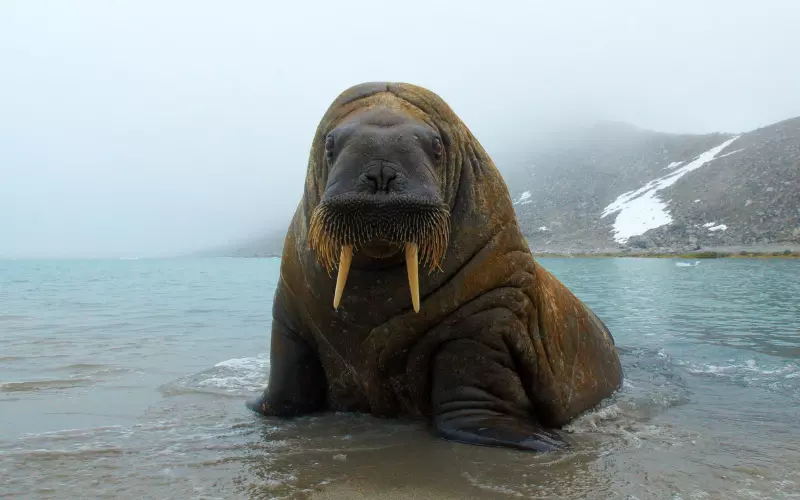
The walrus is a magnificent creature that has been roaming the Earth for thousands of years. Its history can be traced back to the time when the oceans were teaming with life, and the land was covered in ice. These large marine mammals are known for their prominent tusks and their ability to survive in extreme conditions.
The ancestors of the modern-day walrus first appeared around 15 million years ago. These early relatives were smaller in size and had a different set of teeth compared to the ones we see today. As the climate began to cool, ice sheets spread across the northern regions, creating the perfect habitat for these adaptable creatures. They soon evolved to become the large and robust animals we are familiar with today.
Throughout history, walruses have played a significant role in the lives of indigenous peoples who inhabit the Arctic regions. These communities have relied on the walrus for food, shelter, and materials to make tools and clothing. The tusks, in particular, have been highly valued for their ivory, which has been used for carvings and artwork. However, this has unfortunately led to overhunting in the past, resulting in a decline in walrus populations.
Today, the walrus continues to face challenges due to climate change and habitat loss. The melting ice and rising sea levels threaten their ability to find food and reproduce. Conservation efforts are being made to protect these magnificent creatures and ensure their survival for future generations. With increased awareness and understanding, we can help preserve the history of the walrus and its important place in our natural world.
Importance of Walrus
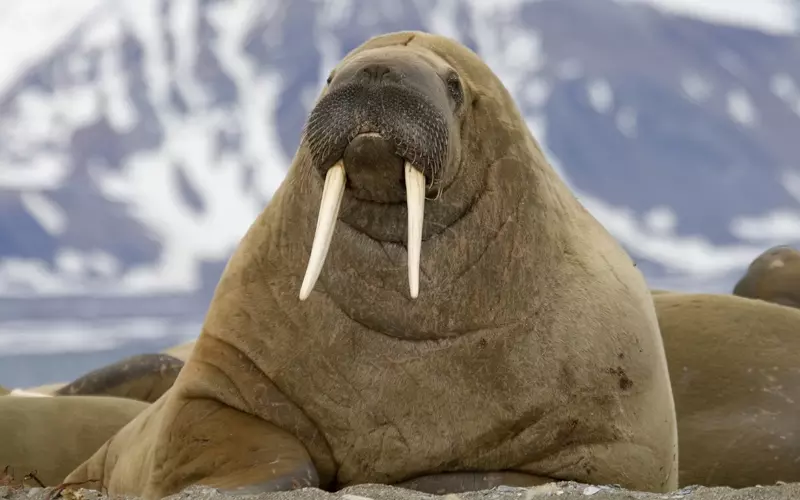
The walrus is a magnificent and unique creature that plays an important role in our ecosystem. It is important to study and understand the walrus because it helps us learn more about our environment and how we can protect it. In addition, the walrus serves as an indicator of the health of the Arctic ecosystem, which is vital for maintaining the balance of nature.
Firstly, studying the walrus provides valuable information about the Arctic ecosystem. By observing their behaviour, scientists can gain insights into the changes happening in their habitat, such as the melting sea ice. These observations can help us understand the impact of climate change on the Arctic and the entire planet. Furthermore, studying the walrus helps us learn about their diet, reproduction, and migration patterns, which are crucial for maintaining their population and the overall health of the ecosystem.
Secondly, the walrus is an indicator species. This means that its population and overall well-being can tell us a lot about the condition of the Arctic ecosystem. If the walrus population is thriving, it suggests that the ecosystem is healthy and balanced. However, if their numbers decline or their behaviour changes, it could indicate problems in the environment, such as pollution or habitat destruction. Therefore, by studying and protecting the walrus, we can gain important insights into the overall health of the Arctic ecosystem.
The walrus holds great significance in our world. Studying this magnificent creature provides us with valuable knowledge about the Arctic ecosystem, helping us understand the impact of climate change and other environmental factors. Furthermore, the walrus serves as an indicator species, allowing us to monitor the overall health of the Arctic ecosystem. By valuing and protecting the walrus, we can take important steps towards maintaining the delicate balance of nature and preserving our planet for future generations.
Amazing Facts About Walrus
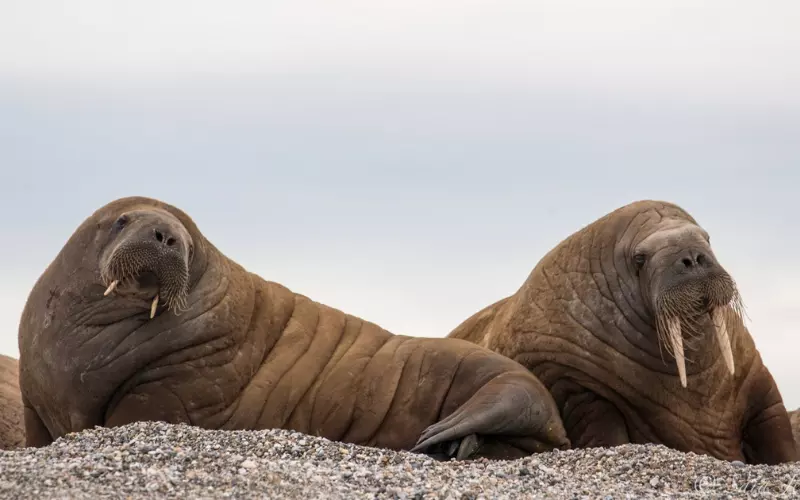
1. Walruses are large marine mammals that live in the cold Arctic regions, mostly found in the Northern Hemisphere.
2. They have a distinctive appearance with long tusks, which are actually elongated canine teeth protruding from the sides of their mouths.
3. Adult male walruses can reach lengths of up to 11 to 12 feet (3.3 to 3.6 meters) and weigh around 2,000 to 3,700 pounds (900 to 1,700 kilograms).
4. Female walruses are slightly smaller, typically measuring around 8 to 10 feet (2.4 to 3 meters) in length and weighing about 1,000 to 2,700 pounds (450 to 1,200 kilograms).
5. The tusks of a walrus can grow to be around 3 feet (1 meter) in length and are primarily used for protection, breaking through ice, and helping them hoist their heavy bodies onto land or ice floes.
6. Walruses have a thick layer of fat under their skin, which helps them keep warm in the freezing Arctic waters.
7. They are excellent swimmers and can reach speeds of up to 21 miles per hour (35 kilometres per hour) in the water, using their front flippers to propel themselves.
8. Walruses are social animals and can often be found in large herds, known as haulouts, consisting of hundreds or even thousands of individuals.
9. Their diet mainly consists of benthic invertebrates like clams, mussels, and snails, which they suck from the ocean floor using their powerful suction abilities.
10. Walruses are excellent divers and can plunge to depths of over 260 feet (80 meters) in search of food, staying submerged for up to 30 minutes at a time.
11. When walruses find a suitable spot to rest, they use their tusks and strong body muscles to climb out of the water and onto the nearest ice floe or land.
12. They are known for their distinct vocalizations, which include grunts, clicks, and bell-like sounds used for communication within their social groups.
13. Walruses have a lifespan of about 30 to 40 years, although some individuals have been known to live up to 50 years or more.
14. They have few natural predators, with polar bears and orcas being their main threats, particularly when they are in vulnerable positions on land or ice.
15. Walruses are considered vulnerable due to habitat loss caused by climate change, as the reduction of sea ice limits their access to resting and mating areas, affecting their overall population.
Can we keep a Walrus as our Pet?
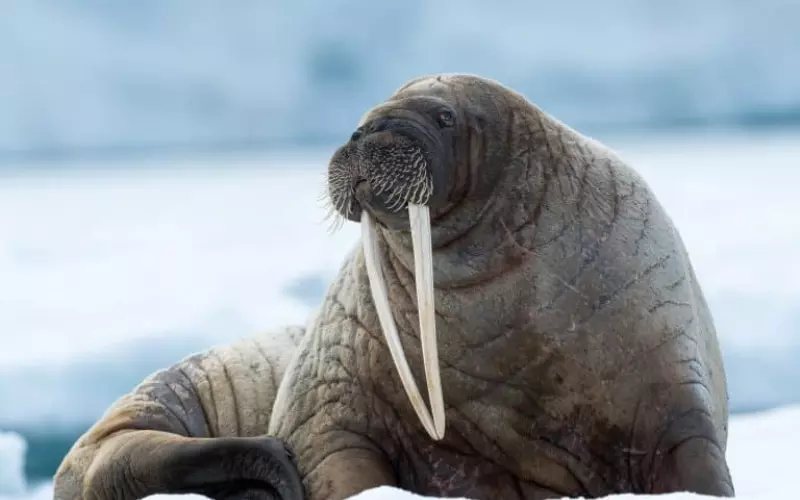
Keeping a walrus as a pet may seem like a fun idea, but it is not suitable or safe. Walruses are large marine animals that require specific living conditions and lots of space to thrive. In addition, they have specific dietary needs and are difficult to care for. Therefore, it is not advisable to keep a walrus as a pet.
Firstly, walruses are enormous creatures and need a natural habitat like the Arctic or sub-Arctic regions to live comfortably. They are adapted to cold weather conditions and need access to water bodies like the ocean or large lakes. It is almost impossible to recreate such an environment in a typical home, making it difficult to provide the walrus with a proper living space.
Secondly, walruses have unique dietary requirements. Their diet mainly consists of marine animals like clams, fish, and shellfish. Providing such specific food can be challenging and expensive. It would also be challenging to maintain their weight and health with a diet that is not part of their natural habitat.
Lastly, walruses are wild animals and are not domesticated. Due to their instincts, they can become aggressive and pose a dangerous threat to humans. Their sheer size alone can be a risk factor, as they can unintentionally cause harm even when playing or trying to interact with their owners.
Keeping a walrus as a pet is not suitable due to their need for a specific natural habitat, unique dietary requirements, and potential dangers they pose. Instead of keeping them as pets, it is better to admire these amazing creatures from afar and support efforts to conserve and protect them in their natural environment.
Size of Walrus

The walrus is a magnificent creature known for its impressive size. They are one of the largest marine mammals in the world and can grow up to 11.5 ft (3.5 m) in length. That’s even longer than a small car! Male walruses are usually bigger than females, weighing around 2,000 kg (4,400 lbs), while females weigh about 1,300 kg (2,866 lbs). They are so big and strong that they often weigh as much as a grand piano!
Despite their massive size, walruses are excellent swimmers. They have broad and strong flippers that help them glide through the water effortlessly. These flippers also come in handy when they need to haul themselves out of the water and onto the ice. Walruses are known for their unique tusks, which can grow up to 3 ft (1 m) long. These tusks are actually elongated canine teeth, and both males and females have them. They use their impressive tusks to break ice, defend themselves, and even help them get out of the water onto solid ground.
The size of a walrus is truly remarkable. They are one of the biggest creatures in their habitat and have adapted to their environment in amazing ways. Their large bodies, strong flippers, and long tusks make them well-suited for life in the Arctic. So next time you think about the size of a walrus, imagine an animal as big as a car, gracefully swimming in the freezing waters of the Arctic Ocean.
Habitat of Walrus
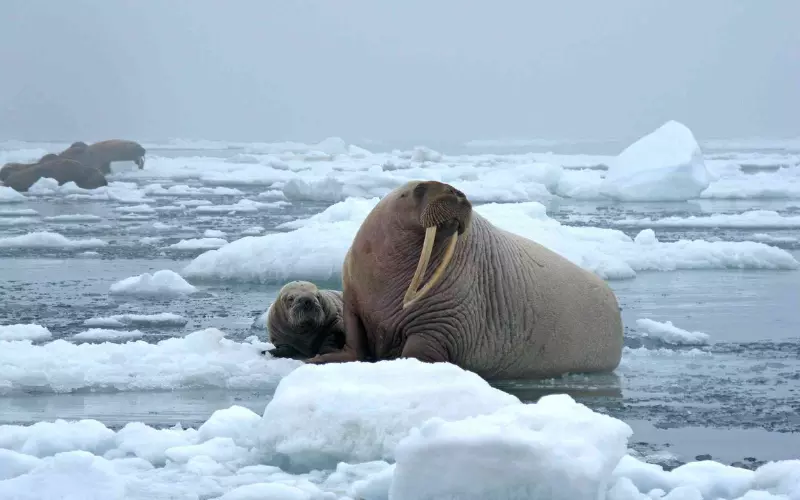
The habitat of the walrus is in the cold Arctic regions near the North Pole. It can be found in places such as Alaska, Canada, Greenland, and Russia. These areas have icy waters and rocky shores, which are perfect for the walrus to live in.
The walrus spends most of its time in the water, swimming and diving for food. It uses its strong flippers to navigate through the icy waters. When it needs to rest, it hauls itself out onto the rocky shores or ice floes. These resting spots are important for the walrus to give birth to their young and take care of them.
The walrus is well adapted to its habitat. Its thick blubber layer helps keep it warm in the freezing waters, and its long tusks are used for many purposes, such as digging for food and hauling its heavy body out of the water. The walrus also has a tough skin that protects it from the sharp edges of the ice.
The habitat of the walrus is in the cold Arctic regions near the North Pole. It lives in icy waters and rocky shores, using its flippers to swim and its tusks to dig for food. The walrus is well adapted to its environment with its thick blubber, long tusks, and tough skin.
Classification of Walrus

The walrus is a fascinating animal that belongs to the group of marine mammals called pinnipeds, which means “fin-footed” in Latin. There are three recognized species of walrus: the Atlantic walrus, the Pacific walrus, and the Laptev walrus. These species can be found in the cold waters of the Arctic Ocean.
Walruses are large creatures, with males being much bigger than females. On average, males can weigh up to 3,700 pounds and measure around 11.5 feet long, while females usually weigh around 2,700 pounds and are about 9.8 feet long. They have a thick layer of fat that helps them to stay warm in freezing temperatures.
These impressive animals have distinct features that make them easy to recognize. Both male and female walruses have long tusks, which are actually elongated canine teeth. These tusks can reach lengths of up to three feet in males and two feet in females. Walruses also have large flippers that they use for swimming and to haul themselves onto the ice or land.
Walruses are a type of marine mammal that falls under the category of pinnipeds. There are three different species of walrus, and they can be found in the icy waters of the Arctic Ocean. They are known for their large size, tusks, and flippers, which help them survive in their harsh environment.
Different Types of Walrus

1. Pacific Walrus: This type of walrus is found in the northern regions of the Pacific Ocean. It has long ivory tusks that can grow up to 3 feet long. Pacific walruses use their tusks to break through ice and for defence against predators.
2. Atlantic Walrus: Atlantic walruses are mainly found in the northern regions of the Atlantic Ocean. They have shorter and thicker tusks compared to their Pacific relatives. These walruses are known for their immense size, with adult males weighing up to 3,700 pounds.
3. Laptev Walrus: The Laptev walrus resides in the Arctic region near Russia. It has a unique feature called a “W-shaped” upper lip. These walruses often rely on sea ice as a resting platform and use their prominent tusks to dig breathing holes in the ice.
4. Siberian Walrus: Also known as the “Ob Bay walrus,” this walrus species lives in the Ob Bay of the Russian Arctic. They have unique patterned skin with dark patches and shorter tusks. Siberian walruses have adapted well to their harsh environment, including long periods of freezing temperatures.
5. Greenland Walrus: Greenland walruses inhabit the frigid waters surrounding Greenland and the Canadian Arctic. They are known for their massive size and powerful tusks that can reach almost 4 feet in length. These walruses are skilful divers and can swim up to depths of 300 feet.
6. Atlantic Siberian Walrus: This walrus type can be found in both the Atlantic and Siberian regions. It has a distinctive “V-shaped” upper lip and relatively long tusks. These walruses often travel in large social groups and use vocalizations to communicate with one another.
7. Alaskan Walrus: Alaskan walruses occupy the Bering Sea and the neighbouring coastlines. They have a stocky build and short tusks. These walruses are exceptional swimmers, capable of reaching speeds of up to 21 miles per hour.
8. Chukotka Walrus: The Chukotka walrus is native to the Chukotka region of Russia, situated between the Bering Strait and the East Siberian Sea. They have a broader head and shorter tusks compared to other types of walruses. Chukotka walruses spend much of their time resting on ice floes.
9. Kara Sea Walrus: Kara Sea walruses inhabit the Kara Sea, a marginal sea of the Arctic Ocean. They have a slender and elongated body and relatively long tusks. These walruses show exceptional agility in the water, allowing them to navigate through icy waters with ease.
10. Norwegian Bay Walrus: This walrus type can be found along the northern coast of Norway and parts of the Barents Sea. Norwegian Bay walruses have slender bodies and short tusks. They are known for their distinct vocalizations, which they use to communicate during mating and social interactions.
Geographical Presence of Walrus
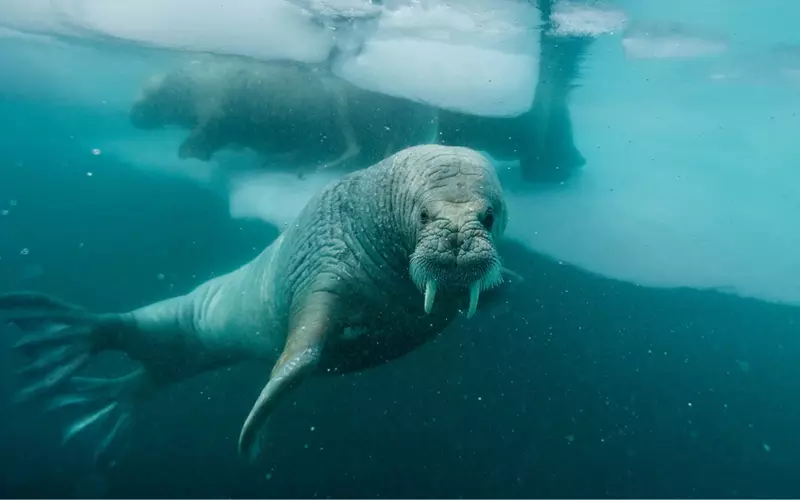
The Walrus is found in the Arctic region. This is a very cold area located in the northern part of our planet. It is home to many unique animals, and the Walrus is one of them. These amazing creatures can be seen swimming and resting on the ice in the Arctic Ocean. They have long tusks, thick blubber to keep them warm, and big flippers to help them move through the water.
However, you will not find the Walrus in other parts of the world, like the warm tropical regions or the hot deserts. They need the cold and icy conditions of the Arctic in order to survive. The Walrus have evolved to adapt to this extreme environment, and they have become well-suited to live there. Their bodies have special features that allow them to swim and dive in icy waters and withstand freezing temperatures.
The Walrus is a fascinating animal that lives in the Arctic region. This region is very cold and located in the northern part of the world. While you won’t find Walruses in warm and tropical places, they are perfectly adapted to the icy environment of the Arctic. It’s amazing how animals can adapt to different habitats to survive and thrive.
Diet of Walrus’s

The diet of a walrus is mainly made up of food from the ocean. These clever creatures are excellent divers and spend most of their time hunting for fish, clams, and other small sea creatures. They use their long and sharp tusks to stir up the sand and mud at the bottom of the ocean, where their food is hidden.
Walruses are not picky eaters at all! They can eat almost anything that they find in the water, including shrimps, crabs, snails, and even octopuses. They are also known to feast on shellfish like clams and mussels. These tasty treats provide them with a good source of protein, which helps them stay strong and healthy.
When it’s mealtime, walruses dive down to the ocean floor and use their sensitive whiskers to locate their prey. They have a really good sense of touch and can easily detect the movements of their food hidden beneath the sandy ocean floor. Once they find their target, they suck it up with their strong lips and enjoy a nice meal.
The diet of a walrus revolves around seafood like fish, clams, and other small sea creatures. They have sharp tusks to find their food and enjoy many tasty treats from the ocean. Their sensitive whiskers help them locate their prey, and they use their strong lips to eat. Walruses are amazing hunters and rely on the ocean to find their dinner.
Locomotion of Walrus’s
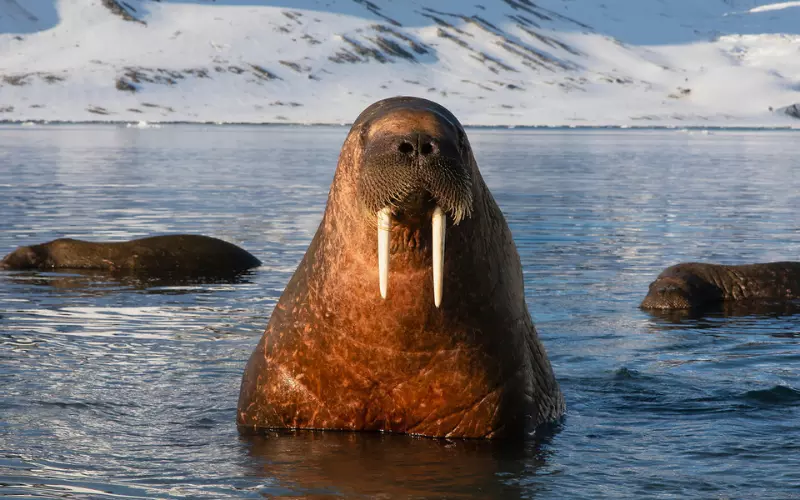
The walrus is a large marine mammal that moves around uniquely. These amazing creatures use their strong flippers to swim gracefully in the water. Their flippers help them glide through the ocean currents, just like a bird soaring through the air. Walruses are excellent swimmers and can travel long distances, often diving deep into the sea to find their food.
When it’s time to rest or move around on land, walruses use their flippers to push themselves forward while they wiggle their bodies. It may not be as graceful as their swimming, but it gets the job done! They can awkwardly shuffle or crawl on their bellies, using their front flippers to propel themselves forward. This mode of transportation may seem a bit funny, but it helps walruses reach the safety of land when they need to rest or give birth to their young.
The way walruses move is fascinating. With their sleek swimming skills in the water and their funny belly shuffle on land, these creatures show us that there’s more than one way to get around in the animal kingdom.
Social and Sexual Behaviour of Walrus’s
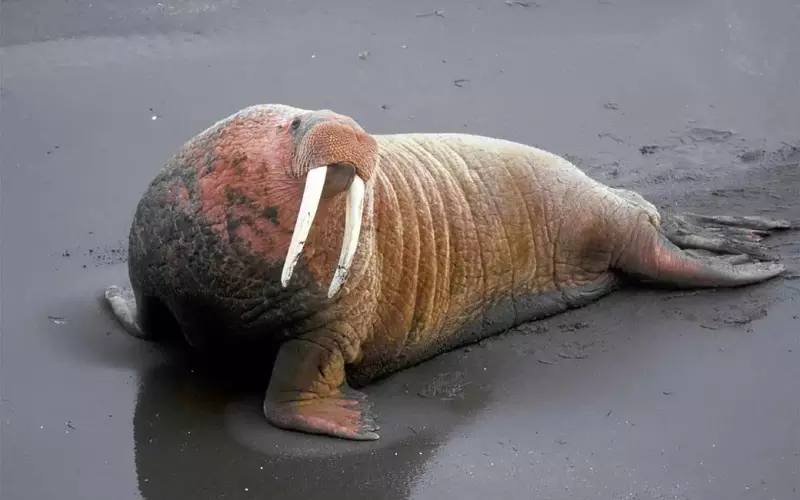
Walruses are large marine mammals that live in the cold Arctic regions. They are known for their unique social and sexual behaviour.
In terms of their social behaviour, walruses are highly gregarious animals. They form large herds or groups, both on land and in water, called “haulouts.” These groups can consist of several hundred to thousands of individuals. Being part of a herd provides them with protection from predators, such as polar bears or killer whales. Within these herds, walruses establish a social hierarchy based on size and strength, with dominant males, called “bulls,” leading the group. This hierarchy is essential for maintaining order and reducing conflict within the herd.
When it comes to sexual behaviour, breeding season is a crucial time for walruses. Male walruses compete to establish dominance over a territory on the ice called “lek.” The dominant bull gathers a group of females, called “cows,” in his territory for mating. These females typically give birth to one calf after a gestation period of approximately 15 months. The bulls engage in intense battles to defend their territories and females from other males vying for the same breeding rights.
Walruses exhibit fascinating social and sexual behaviours. They form large herds for protection and establish a social hierarchy within these groups. During the breeding season, the dominant male gathers females within his territory for breeding while engaging in fierce battles with other males. These behaviours ensure the survival and continuation of their species in the harsh Arctic environment.
Reproduction and Lifecycle of Walrus’s
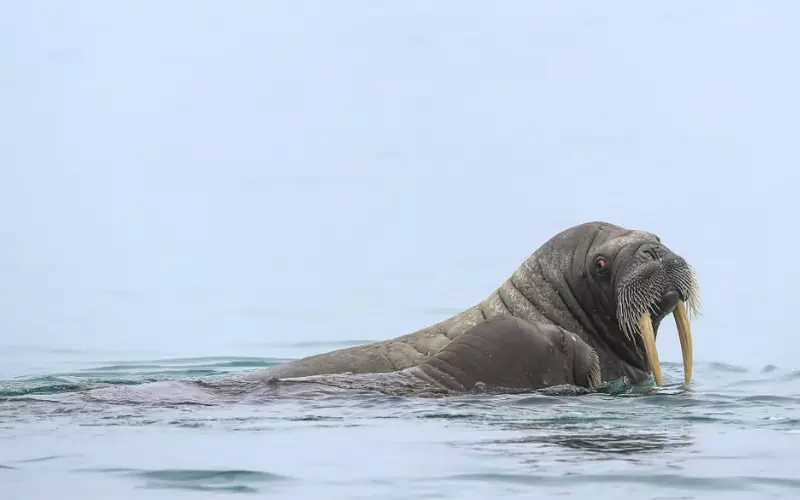
Walruses are fascinating creatures that have a unique reproduction and life cycle. They reproduce through a process called sexual reproduction, where a male walrus mates with a female walrus to produce offspring. The males compete with each other to win the attention of a female by displaying their long tusks and making loud noises. Once a male is chosen, he mates with the female, and she becomes pregnant.
The female walrus carries her baby, called a calf, in her womb for about 15 to 16 months. After this long period, she gives birth to a single calf either on land or on floating ice. The calf is born with a thick layer of fat to keep it warm in the cold Arctic waters. At birth, the calf weighs around 100 pounds and is about 3 to 4 feet long. It depends on its mother for milk, and she nurses it for about a year until it is strong enough to find food on its own.
As the calf grows, it learns important survival skills from its mother. It learns how to swim, dive, and find food. The young walrus follows its mother closely, observing her every move. They stay together for several years, forming a strong bond. Once the calf reaches maturity, usually around 6 years old, it is ready to mate and start its reproductive cycle. Some walruses can live up to 40 years in the wild, and during their lifetime, they can give birth to several calves, ensuring the survival of their species.
Walruses reproduce through sexual reproduction, and the female gives birth to a single calf after a long gestation period. The calf relies on its mother for nourishment and guidance until it becomes independent. This unique life cycle allows walruses to adapt and thrive in their Arctic habitat.
Threats to Walrus’s

Walruses are incredible creatures that live in the Arctic and sub-Arctic waters. However, they face several threats that endanger their existence. One major threat is the loss of sea ice. Walruses depend on the ice to rest, give birth, and find food. With rising temperatures, the sea ice is melting at an alarming rate, leaving walruses with limited space to survive. This puts them at risk of starvation and exhaustion.
Another significant threat to walruses is their vulnerability to pollution. As human activities increase, so does the pollution in the ocean. Chemicals, oil spills, and litter find their way into the water, posing serious risks for these animals. Pollution can harm walruses’ health, leading to diseases, reproductive problems, and even death. We must take steps to reduce pollution and protect their habitats.
Lastly, walruses are also threatened by hunting and poaching. Although regulated hunting is permitted in some regions, illegal hunting for their ivory tusks remains a major concern. Walruses have been hunted for centuries, and this unsustainable practice continues to push them towards endangerment. Strict laws and enforcement are necessary to combat illegal hunting and ensure the survival of these magnificent creatures.
Walruses face several threats to their existence. Loss of sea ice, pollution, and hunting are the main culprits. It is important for us, as responsible inhabitants of this planet, to take action towards protecting their habitats, reducing pollution, and combating illegal hunting. By doing so, we can help ensure the survival and well-being of these magnificent animals that play a crucial role in the Arctic ecosystem.
Conclusion
Walruses are fascinating creatures found in the Arctic region. They have a long history of coexistence with humans and are known for their distinctive features and behaviour. These large marine animals are often spotted near the icy shores, where they spend their time swimming, resting, and hunting for food.
One interesting fact about walruses is their impressive size. They can grow up to 10 feet in length and weigh over 1.5 tons, making them one of the largest animals in the world. Their tusks, which are actually elongated canine teeth, can reach up to three feet in length. These tusks are used for various purposes, such as foraging on the ocean floor and helping them haul themselves onto ice shelves.
Walruses primarily inhabit the Arctic region and are well-adapted to extreme cold temperatures and icy conditions. They rely on sea ice for resting, breeding, and giving birth to their young. However, due to climate change, the melting of sea ice poses a major threat to their habitat and survival. Conservation efforts are crucial to ensure the protection of these magnificent animals and their habitat.
Walruses are fascinating creatures due to their history, size, habitat, and unique features. They play an important role in the Arctic ecosystem and are a symbol of the region’s natural beauty. We need to learn about and appreciate these creatures, as well as take steps to protect their environment for future generations to enjoy and learn from.
FAQ’s
What is a walrus?
A walrus is a large marine mammal known for its long tusks and blubbery body.
Where are walruses typically found?
Walruses can be found in the Arctic regions of the Northern Hemisphere.
What do walruses eat?
Walruses primarily feed on a diet of molluscs and other small marine invertebrates.
How big can a walrus get?
Adult male walruses can reach lengths of up to 12 feet and weigh between 2,000 to 3,700 pounds.
Are walruses social animals?
Yes, walruses are highly social animals and can be found in groups known as herds.
Do walruses make any sounds?
Walruses are known to produce a series of distinct vocalizations, including barks, roars, and whistles.
How long do walruses live?
Walruses have a lifespan of approximately 40 to 50 years in the wild.
What is the purpose of a walrus’s tusks?
Walrus tusks serve multiple purposes, including defence, establishing dominance, and aiding in climbing out of the water.
Can walruses swim?
Yes, walruses are powerful swimmers and can travel long distances in the water.
Are walruses threatened or endangered?
The global population of walruses is currently stable, but they are considered protected species in many countries.
Can walruses sleep in the water?
Yes, walruses can sleep in the water, often floating on their backs and resting their heads on ice floes.
Do walruses have any natural predators?
In their natural habitat, walruses have few predators. However, polar bears and killer whales can occasionally prey on them.
How do walruses stay warm in freezing waters?
Walruses have thick blubber layers that provide insulation against the cold temperatures of the Arctic waters.
Can walruses communicate with each other?
Yes, walruses communicate using a combination of vocalizations, body gestures, and physical contact.
Do walruses migrate?
Yes, walruses undertake seasonal migrations in search of food and suitable breeding grounds.

Hi there! I’m Morgan Gutierrez, and I love animals! I work as a Seasonal Animal Care Specialist at Brookfield Zoo and also teach people about animals, which is super fun. I studied at Valparaiso University in Lockport, Illinois, where I learned even more about these amazing creatures.
I’m not just about taking care of animals; I write articles about them, too! I explore and share many interesting animal stories, from cute kittens to giant elephants.
In the past, I’ve worked with veterinarians, helped with research, and even been an Animal Ambassador, bringing animals closer to people. Animals are my passion, and I enjoy helping others learn about them. So, if you ever want to know about animals, feel free to ask. I’ll explain it in a way that’s easy to understand, just like talking to a friend!

